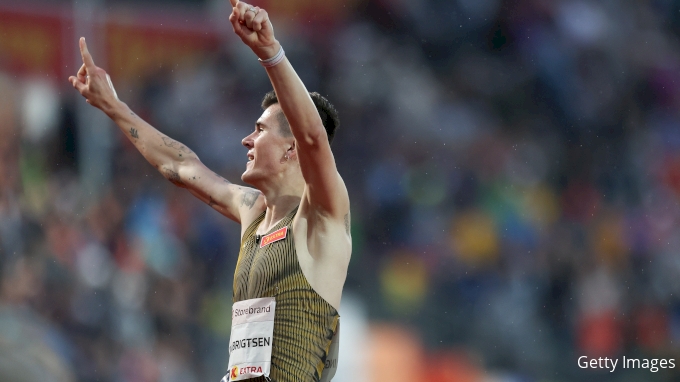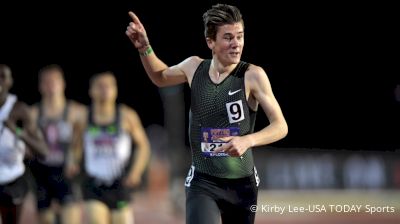An Ode To Jakob: One Writer's Journey To Oslo To See Ingebrigtsen Race
An Ode To Jakob: One Writer's Journey To Oslo To See Ingebrigtsen Race
Traveling over 3,500 miles to Oslo, a writer from New York City and devotee of the 'Ingebrigtsen Way' found understanding watching a star leave his feet.

OSLO – The Edvard Munch Museum forbids sko med brodder: shoes with spikes. Three kilometers away at Bislett Stadium, 14,000 spectators have gathered just to see shoes with spikes.
One pair of these feet is the main attraction. Tonight, we’ll see these feet slip into size 45 Dragonfly spikes and make three and three quarter laps of the track. 768 steps. On average. I’ve been counting.
I’ve been counting for a while. It was in 2018 that some Americans first saw him with their own eyes. A select few had the privilege of shaking his hand. I was there that night in Palo Alto, where it seemed that the most exciting thing about the 1,500m race was that the pacer wore a backwards hat and had gapped the field. A kick was coming.
A certain tension built in the crowd as the limbs of the pack tightened. The last lap. The pacer dropped at 1,100m. Teasing on the backstretch. A small gap on the rail. And then – he thrust into the lead with 200m to go. The field of seasoned professionals obediently raced for second behind the teenager.
He had arrived. He had arrived.
The race announcers had a difficult time since Craig Engels was also in the race. It would be their first time pronouncing the winner’s name.
Engels. Ingels. Ingelbritsen. “Who picked Ingebrigtsen to win this?” Engelbretsen. Engelbressen. Eagle-Brisson. The announcers dueled in real time as to the letter L’s presence in his last name. Ingebrigtsen. Engelbritsen. Jaycob Ungubritsen. Ingelbrigtsen.
His name is Jakob Ingebrigtsen.
Here in Oslo today, he is an icon, an Olympic champion, a world-record holder. In Manhattan, I cannot ask for his hairstyle. I have to specify fading the sides down to a 1. Right sweep. Hard part with accentuated razoring. Leave about five inches on top but clean up the cowlick. Recently, though, I’ve been asking for the usual.
Jakob has captivated track fans since he came to America and won that 1,500 at Payton Jordan as a 17-year-old. He races often. He wins almost always. He breaks records at will when in peak form. He is one of the most confident runners the sport has ever seen.
Now, following two second-place finishes at the last two World Championship 1,500m finals, the questions he speaks to are not all about being the youngest or amazingest. They concern disappointment paired with boldness, rivalries paired with vengefulness.
Jakob Ingebrigtsen is the protagonist of men’s middle distance running.
- Subscribe To FloTrack To Watch More Track & Field Meets All Year Long
- Check out full coverage of the U.S. Olympic Track and Field Trials
- The Youngest Athletes At The Olympic Trials? It's These High Schoolers
- These Two What-If Scenarios Would Shake Up The U.S. Olympic Trials

I’m not the only one who admires Jakob. Thousands do. Some don’t feel as fondly for his character. Some call him the villain. They just want the winning formula. But understanding Jakob is axiomatic to grasping the Norwegian formula.
I get sad when he loses. On a Sunday in May, Jakob loses to Josh Kerr in the Bowerman Mile. I knew he would let Kerr win. He lined up behind him with a lap and a half to go and tracked him perfectly. Oh, he could have won. He was good for 3:44.5 in the full mile. I immediately set out to an internet forum where I convinced others that Jakob was playing the long game. He wanted to instill false confidence in Kerr. Kerr can gloat all he wants behind those stupid sunglasses. Jakob will win when it counts.
I get anxious whenever he lines up. Visiting the Munch Museum wasn’t a good distraction on race day. Edvard Munch painted pictures of pain and longing, unrequited feelings and loss. Munch mastered the negative emotions, which, I suppose, are synonymous with the human condition. Sometimes that human condition feels synonymous with middle-distance running, even for someone sitting in the bleachers.
Bislett Stadium is sold out. There are crowds outside the gates trying to gain admission. There are crowds on the sidewalk peering through the mesh gates. Fourteen thousand seats are filled, plus an extra seat for the King of Norway, who I’d imagine occupies a throne.
Everyone addresses me in Norwegian. The first thing I encounter in Bislett Stadium is a booth for the 2025 World Championships in Nordic Skiing. They’ll be held in Trondheim. The promoters have set up a Concept2 SkiErg featuring a special graphical display loaded with a racing game. I gather that there’s a 30-second time trial format. The winner will receive a trip to the world championships in cross-country skiing—presumably as a spectator.
The current best is 138 meters in 30 seconds.
I’ve been practicing on a SkiErg three days each week for the last eight months. The Norwegian System originated with cross country skiing. How could I not be using the SkiErg? While children are wildly flailing on the machine, I calculate that the current 30-second high score is only slightly faster than the pace I can hold for 10 kilometers. I break the record by a gigantic margin. The organizer writes down my contact information as my right leg spasms and my veins flush lactate.
Jakob’s 1,500m race is the concluding event at the Bislett Games. It’s hard to focus on anything else. On my phone, I juggle Jakob’s World Athletics performance page and screenshots of past race breakdowns. I’m typing my notes. Imagining splits. Predicting race scenarios.
Before I know it, the men’s 400m hurdles is off. The entire crowd is standing up while I’m seated reviewing my notes. The fellow beside me wants to keep talking. Be quiet! I didn’t come all this way to watch Karsten Warholm.
Jakob strides out from the 1,500m start to the 200m start. He’s all alone. He’s wearing a brown Nike speed suit trimmed with gold pinstripes. I give a shy wave. He returns a wry smile. This is the man I saw in 2018. Yet, it also is not. He retreats to the 1,500m starting line with his competition.
Another character strides toward the 200m start. The Norwegian Narve Gilje Nordås. He placed third behind Jakob in the 1,500m at the 2023 World Championships. It wasn’t a fluke–Nordås ran under 3:30. He’s coached by Jakob’s father. Jakob isn’t coached by his father anymore.
Jakob Ingebrigtsen is a myth. Together with his older siblings and now, especially now, together with Nordås, Jakob is the mythbuster. He's the driving force behind the reemergence of elite European middle-distance and distance running.
Jakob is the protagonist because he attacked the notion that those with European ancestry had limited viability at the top level of the sport. His success, and the success of those who have embraced training like he does, have changed so very much.
Anything Nordås does serves to further legitimize Jakob’s achievements.
The race starts and even the King of Norway is on his feet. Zan Rudolph and Boaz Kiprugot are pacing. Shoes with carbon fiber spike plates tap the synthetic rubber. Jakob settles into third behind the pacers. Just like that race seven years ago, the field obediently settles behind him. Here, they do so as early as possible. The wavelights are programmed for 3:29.00.
It’s 54.90 through the first full lap. It’s cloudy, the stadium lights are on and the most delicate of drizzles hangs over us. Nobody is considering challenging him. There are, indeed, two kings in Bislett Stadium.
Energy is expended as men attempt to improve their positions between 500m and 600m. There’s a bit of a gap to the pacers, though Ingebrigtsen holds on to the rail and the front of the green wavelights, those denoting the goal pace. Minor moves at 700m and a minor tripping toward the back of the field. Though running close to all-out, each competitor knows that to have a chance at winning, his feet must be near Jakob’s. Valuable fuel is wasted on maneuvers that will be forgotten.
We’re at 1:51.45 through 800m. It’s a 3:30 race. The pack densifies as Rudolph steps off. An exhausted Kiprugut falls behind the lights and strafes 100 meters later. In the Bowerman Mile, which is slightly longer than the metric mile, Josh Kerr had already made his move by now. Jakob could have beaten him then. He could beat him today.
There go the boys in their shoes with spikes. Narve Nordås appears to be missing one sko. There’s some fragmentation–only Timothy Cheriyuout is chasing Jakob and he’s doing so as if pulled by the length of a shoestring.
There are four hundred meters left now. The bell rings. These men are Workers Returning Home. Jakob is the foreman of the working class. Faces sad; faces relatable. He controls the race. He controls where the 1,500m has been and where it is going.

Passing him now would be suicide. The clock struck 2:34. A 56 won’t win the race. Now every fraction of a second is precious. Yet, those trailing the leader have extra distance to run just to catch up to him. Then, they have to pass him. Kerr and Jake Wightman, the other Brit who beat him in a 1,500m final, both allowed Ingebrigtsen to lead the race while waiting until 200m to execute their desperate sprints. They figured that 1,300m was his weakest point.
With 200m to go, though, having failed to achieve meaningful separation from Timothy Cheruiyot, Jakob labors on. You can’t let them do this to you again, Jakob. Today, it turns out that nobody has the confidence to try.
He starts to separate with 150m to go. Off the curve, it’s his. Once again, his competitors will have only seen the back of his head. It’s no wonder they try to rattle him with their podcast interviews and disrespectful nicknames and kicks planned eight months in advance. That’s all they have. He has 14,000. They’re all in a mania! They’re seeing what they came to see. I’m seeing what I came to see. My fingers are crossed that he’ll pass by once more for his victory lap.
A hundred meters remaining becomes 90, then 80, then 70, Jakob and his old rival have broken away, 60, 50, forty–Cheruiyot has another gear! He pulls up, he pulls even, such a reticent kicker! Jakob was never supposed to lose this guy again. That was the prophecy. Now it’s all at risk. They’re Hode Ved Hode: head-by-head. Jakob has but a moment to assess what’s happening. The stadium wills him forward, but it looks like one Timothy is about to break the heart of another. Jakob dives across the finish line, dead even with Cheriuyot’s kneecaps.
The stadium falls silent. I’m back to counting. Jakob stays on the ground for 10.5 seconds.
Jakob, you are The Yellow Log in the forest. The felled tree on freshly fallen snow. As Munch did so many years ago, you have reached the pinnacle by unlearning. All of the time spent practicing using your feet. When it mattered most, you used your torso. And now the expanse of the Nordic forest is a metaphor for the extension of your own limbs, the never ending possibilities stemming from an art form so uniquely yours.
The winner of the race is announced to be Jakob Ingebrigtsen.

Tim O’Hearn is a software engineer who lives in the West Village. He runs with Central Park Track Club.
FloTrack Is The Streaming Home For Many Track And Field Meets Each Year
Don’t miss all the track and field season action streaming on FloTrack. Check out the FloTrack schedule for more events.
FloTrack Archived Footage
Video footage from each event will be archived and stored in a video library for FloTrack subscribers to watch for the duration of their subscriptions.
Join The Track & Field Conversation On Social
- Follow us on Twitter @FloTrack
- Follow us on Instagram @flotrack
- Follow us on TikTok @flotracktv
- Watch us on YouTube
- Like us on Facebook
